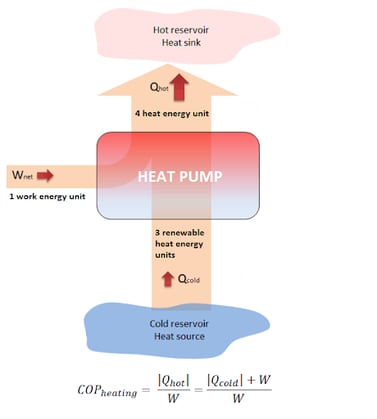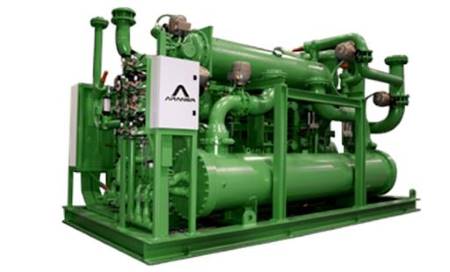The district energy system is quickly becoming one of the most popular heating and cooling alternatives in urban areas due its economic and environmental advantages.
While employing a district energy plant that distributes heating to wider areas is not a new idea, these structures are currently becoming modernized, turning into sustainable options in the face of current decarbonization needs.
What is district energy system and what are the benefits of these types of centralized heating systems? Keep reading to find out about the most exciting current possibilities in this are exploring new renewable, locally-produced energies in District Heating.
What is a district energy system
A district energy system is a type of heating and cooling structure that generates energy in a centralized location and then distributes it through a network of underground insulated pipes.
These systems thus provide heating and cooling to both residential and commercial facilities through networks that can connect from just a few buildings to thousands of them.
How does a district energy system work
A district energy system works through connecting three types of structures:
- A thermal energy plant or production plant. The biggest and most complex among district energy systems, the district energy plant consists of a conglomerate of elements (chillers, boilers and heat pumps) in charge of generating thermal energy.
- The distribution network or distribution piping network (DPN), which carries thermal energy to end users and buildings.
- End-user interfaces, including energy transfer stations and integrated control systems. These are in charge of transferring this energy to each particular building and allowing end-users to control their energy use.
It’s this arrangement that makes a district heating system different to other heating and cooling structures: individual buildings don’t need their own heating or cooling equipment. Energy generation is thus simplified and more efficient.
The sources for thermal energy in a district energy system are also part of what makes these structures a sustainable alternative.
While it’s true that a district energy plant may generate energy from burning fossil fuels (and most did so in the past), manufacturers and cities today are exploring new renewable, locally-produced energies in DH.
Some of the most prominent sources for energy in district heating include:
- Combined heat and power (CHP) plants, which achieve maximum efficiency by avoiding the costly energy losses linked to traditional power plants.
- Using waste heat from industrial processes.
- Electrification of the heating production with Heat Pumps and using renewable energy sources as heat source such as geothermal, sewage water, river/sea water, industrial waste heat, etc.

Benefits of implementing a district energy system
- The possibility to incorporate cleaner energy sources, as discussed above.
- Minimized energy consumption. This is due to a number of reasons. First, the fact that heating and cooling are provided from a central plant means less energy consumption. Secondly, different choices in energy sources bring about other efficiency benefits. For instance, the option of combined heat and power (CHP) plants (or cogeneration plants) can achieve energy efficiencies way above conventional power-only plants, reaching 80% operational efficiency. Additionally, they reduce the need for primary energy by 50%, as they co-generate electricity and heat.
- Economic savings. Initially, opting for a district energy system may represent an important investment, as whole structures are sometimes needed to be put into place. However, district heating brings long term economic savings in terms of energy consumption and operational and maintenance costs.
The option to use energy sources that are alternative to fossil fuels may also mean a reduction of the need to import fuel or natural gas. At the same time, a district energy system is able to avoid costly peak power expenses, as they’re able to both generate and store energy. - Use of waste energy. Surplus energy from alternative sources can be stored and used via a district energy system at a lowest cost compared to other options. This translates into a more reliable and efficient energy source.
- Versatility. A wide array of energy sources can be combined and integrated into a district energy plant. In fact, these structures may be designed responding to each location’s needs and possibilities.
This means locally-produced energies can also be incorporated at a city level, facilitating sharing processes and building more resilient and collaborative energy models. Production, supply and demand can be coordinated to match local resource use. - Architectural advantages. A district energy system eliminates the need for each building to present a separate and big space for heating and cooling installations. This, in turn, means that buildings score an extra space for valuable activities, providing architectural benefits.
- Reliability and convenience. Instead of relying on individual citizens or buildings to operate their energy systems, each district energy plant is run and monitored by professionals. This provides an extra advantage in terms of operational and maintenance efficiency, guaranteeing all equipment is safely and expertly operated.
District energy system solutions tailored to your project needs: choose Araner
At Araner, we work to provide state-of-the-art district heating and district cooling solutions, allowing project managers to incorporate systems that are sustainable and efficient throughout their whole life cycle.
As such, we’re able to implement customized district heating and district cooling systems that adjust to each project’s needs.
Our Research and Development area represents a powerful tool and competitive advantage, always on the lookout for new solutions and innovations to improve and optimize our systems.
Through our R&D, we’ve been able to provide high efficient large-scale heat pump solutions, implement different heat source and waste heat recovery usage or combine production with thermal energy storage, among other solutions.
We’ve also committed to reduce our customer’s overreliance on fossil fuels. Through the use of modern heat pump technologies, we provide the possibility to capture heat from alternative sources, including industrial wastewater, groundwater, air and seawater, among others.
Additionally, these improvements are accompanied by one of the most competitive prices on the market.
All in all, Araner has quickly become a reliable and competitive supplier for district energy systems, helping companies and cities have access to sustainable heating and cooling solutions.
Want to learn more about district energy systems and their benefits? Get in touch with us: our team of experts will guide you through the potential solutions that best adjust to your project’s needs.











